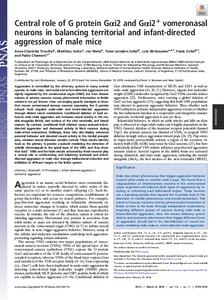Por favor, use este identificador para citar o enlazar este ítem:
https://repositorio.uca.edu.ar/handle/123456789/8682| Título: | Central role of G protein Gαi2 and Gαi2+ vomeronasal neurons in balancing territorial and infant-directed aggression of male mice | Autor: | Trouillet, Anne-Charlotte Keller, Matthieu Weiss, Jan Leinders-Zufall, Trese Birnbaumer, Lutz Zufall, Frank Chamero, Pablo |
Palabras clave: | TERRITORIALIDAD; AGRESIVIDAD; PROTEINAS; COMPORTAMIENTO; SISTEMA LIMBICO | Fecha de publicación: | 2019 | Editorial: | National Academy of Sciences | Cita: | Trouillet A-C, Keller M, Weiss J, et al. Central role of G protein Gαi2 and Gαi2+ vomeronasal neurons in balancing territorial and infant-directed aggression of male mice [en línea]. Proceedings of the National Academy of Sciences. 2019;116(11):5135-5143. doi:10.1073/pnas.1821492116 Disponible en: https://repositorio.uca.edu.ar/handle/123456789/8682 | Resumen: | Abstract: Aggression is controlled by the olfactory system in many animal species. In male mice, territorial and infant-directed aggression are tightly regulated by the vomeronasal organ (VNO), but how diverse subsets of sensory neurons convey pheromonal information to limbic centers is not yet known. Here, we employ genetic strategies to show that mouse vomeronasal sensory neurons expressing the G protein subunit Gαi2 regulate male-male and infant-directed aggression through distinct circuit mechanisms. Conditional ablation of Gαi2 enhances male-male aggression and increases neural activity in the medial amygdala (MeA), bed nucleus of the stria terminalis, and lateral septum. By contrast, conditional Gαi2 ablation causes reduced infant-directed aggression and decreased activity in MeA neurons during male-infant interactions. Strikingly, these mice also display enhanced parental behavior and elevated neural activity in the medial preoptic area, whereas sexual behavior remains normal. These results identify Gαi2 as the primary G protein α-subunit mediating the detection of volatile chemosignals in the apical layer of the VNO, and they show that Gαi2+ VSNs and the brain circuits activated by these neurons play a central role in orchestrating and balancing territorial and infant-directed aggression of male mice through bidirectional activation and inhibition of different targets in the limbic system. | URI: | https://repositorio.uca.edu.ar/handle/123456789/8682 | ISSN: | 0027-8424 (print) 1091-6490 (online) |
Disciplina: | MEDICINA | DOI: | 10.1073/pnas.1821492116 | Derechos: | Acceso Abierto | Fuente: | Proceedings of the National Academy of Sciences. 2019;116(11):5135-5143 |
| Aparece en las colecciones: | Artículos |
Ficheros en este ítem:
| Fichero | Descripción | Tamaño | Formato | |
|---|---|---|---|---|
| central-role-of-g-protein.pdf | 1,71 MB | Adobe PDF |  Visualizar/Abrir |
Visualizaciones de página(s)
280
comprobado en 03-dic-2025
Descarga(s)
188
comprobado en 03-dic-2025
Google ScholarTM
Ver en Google Scholar
Altmetric
Altmetric
Este ítem está sujeto a una Licencia Creative Commons

